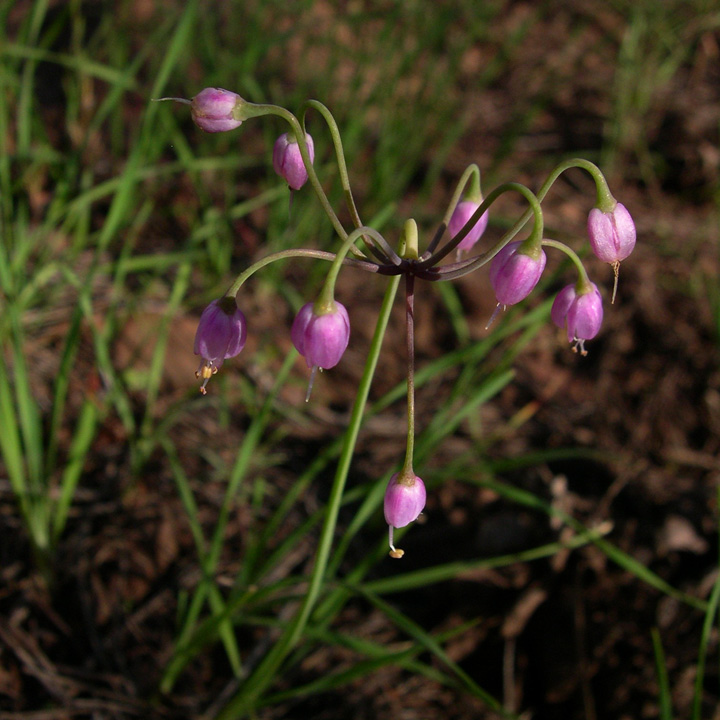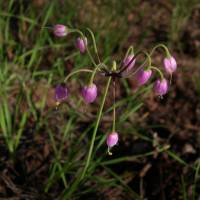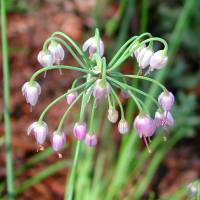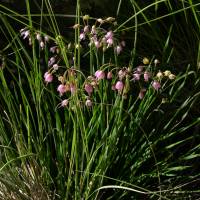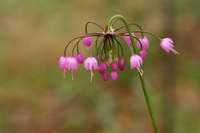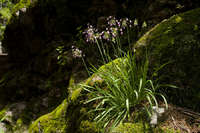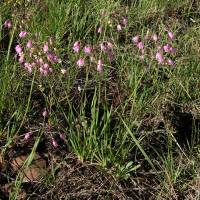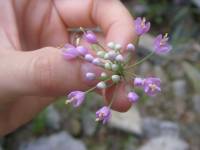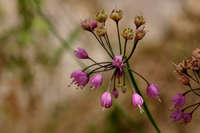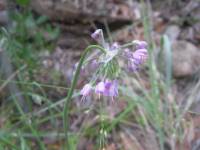Bulbs 2-5+, clustered, often short-rhizomatous at base, rhizome not stout or iris-like, oblong, elongate, 1-3 × 0.8-1.5 cm; outer coats enclosing 1 or more bulbs, grayish or brownish, membranous, minutely striate, cells in regular vertical rows, narrowly elongate, fibers persistent, parallel, few; inner coats white to pink or reddish, cells in regular vertical rows, narrowly elongate. Leaves persistent, green at anthesis, 3-5, basally sheathing, sheaths not extending much above soil level; blade solid, flat, channeled to broadly V-shaped in cross section, 10-25 cm × 1-6 mm, margins entire or denticulate. Scape persistent, sometimes 2 or more produced successively from single bulb, usually clustered, nodding, solid, terete or ridged, particularly distally, sometimes flattened and narrowly winged, abruptly recurved near apex, 10-50 cm × 1-3 mm. Umbel persistent, cernuous, loose, 8-35-flowered, hemispheric, bulbils unknown; spathe bracts persistent, 2, 3-veined, lanceolate, ± equal, apex acuminate, beakless. Flowers campanulate, 4-6 mm; tepals ± erect, pink or white, elliptic-ovate, ± equal, withering in fruit, margins ± entire, apex ± obtuse, at least outer tepals strongly incurved, midribs not thickened; stamens exserted; anthers yellow; pollen yellow; ovary conspicuously crested; processes 6, flattened, ± triangular, margins entire or toothed; style exserted, linear, ± equaling stamens; stigma capitate, scarcely thickened, unlobed; pedicel 6-25 mm, becoming stouter in fruit, elongating and bending abruptly upward from near point of attachment. Seed coat dull or shining; cells smooth, minutely roughened, or each with minute, central papilla. 2n = 14.
Flowering Jul--Oct. Widely distributed on moist soils in mountainous and cool regions; 600--3500 m; Alta., B.C., Ont., Sask.; Ala., Ariz., Ark., Colo., D.C., Ga., Idaho, Ill., Ind., Iowa, Ky., Md., Mich., Minn., Mo., Mont., Nebr., N.Mex., N.Y., N.C., Ohio, Oreg., Pa., S.C., S.Dak., Tenn., Tex., Utah, Va., Wash., W.Va., Wis., Wyo.; Mexico.
Allium cernuum is the most widespread North American species of the genus. It is closely related to A. stellatum, and the character commonly used to differentiate them has been umbel orientation. In both species, the inflorescence is nodding in bud, but in A. stellatum it usually becomes erect by anthesis. In A. cernuum the peduncle remains permanently recurved near the apex, although the inflorescence may sometimes become erect overall, or nearly so. While this character is helpful in identification, an almost exclusive reliance on it (even by one of the present authors in his youth) has obscured other clearer distinctions between the species and has confused their geographic ranges. More reliable characters for differentiating these species are bulb shape (elongate in A. cernuum, ovoid in A. stellatum) and perianth shape (campanulate in A. cernuum, stellate in A. stellatum). Unfortunately, perianth shape is often difficult to see in herbarium specimens.
Perennial herb with two to five or more bulbs flowering stem 30 cm - 0.6 m tall
Leaves: three to five, arising near the base, shorter than stem, 10 - 45 cm long, 2 - 8 mm wide, flat, linear, soft, sometimes small-toothed.
Inflorescence: a nodding, dome-shaped umbel of eight to thirty-five flowers raised on a single narrow stalk and subtended by two lance-shaped, persistent bracts.
Flowers: on 12 - 25 mm long stalks, white to pink to rose-colored, 4 - 6 mm long, bell-shaped, with six tepals that wither in fruit. Stamens six, exserted. Anthers yellow.
Fruit: a short, three-lobed capsule.
Bulbs: clustered, up to 3 cm tall, slender, conic, gradually tapering into the stem, and encased in a brownish or grayish membranous coating.
Similar species: Allium stellatum is similar but has stiff leaves and an upright, not nodding, umbel during full flower. However, since the umbel can sometimes be nodding, it is a good idea to compare bulb and flower shape as well.
Flowering: late June to early October
Habitat and ecology: Frequent in remnants of prairies. Also found along railroads and in open woods.
Occurence in the Chicago region: native
Notes: Allium cernuum is the most widespread species of the genus in North America.
Etymology: Allium comes from the Latin word for garlic. Cernuum means nodding.
Author: The Morton Arboretum
Infrequent throughout the state although there are no records from the southwestern counties. Where it is found, especially on the banks of streams, it is genrally common except in marshes and springy places. This species has a wide range of habitat and distribution. It is usually found on the high and dry banks of streams but it is also found in low, sedge marshes, in marly springy places, and on gravelly bars in rivers. The color of the flowers ranges from white to deep pink. The white form has been named and I have it from Wabash County.
Indiana Coefficient of Conservatism: C = 4
Wetland Indicator Status:
Duration: Perennial
Nativity: Native
Lifeform: Forb/Herb
General: Herbaceous perennial monocot, to 60 cm tall, stems scapose, slender, herbage onion-scented, arising from a bulb, the bulb narrowly ovoid with a long neck, 3-6 cm long, sometimes borne on a short rhizome.
Leaves: Several per bulb, basally sheathing, flat to V-shaped in cross-section, shorter than the scape, to 25 cm long and 2-4 mm wide, margins entire to denticulate.
Flowers: Scape 10-60 cm tall, abruptly recurved near the apex, the inflorescence a nodding, many flowered terminal umbel. Flowers subtended by 2 short deciduous bracts; tepals pale pink-lavender, campanulate, persistent; tepal segments distinct or nearly so, 4-10 mm long, ovate to oblong; stamens and styles exserted, the stamens 6, adnate to the perianth base, styles 3.
Fruits: A strongly crested capsule with 6 seeds. Pedicels elongate in fruit, bending upward, so the capsules are held erect.
Ecology: Found in moist soils, in cool, shady places within Ponderosa pine, Gambel's oak, sagebrush, Douglas fir, and aspen communities; from 2,000-11,500 ft (610-3505 m); flowering July-October.
Distribution: Widespread across much of North America, including CAN and n. MEX. Not present in OK, KS, CA, NV, FL, or LA.
Notes: This species is easily recognized by its pinkish purple, nodding umbel and onion scent. FNA notes that; "Allium cernuum is the most widespread North American species of the genus. It is closely related to A. stellatum, (found in the midwestern US) and the character commonly used to differentiate them has been umbel orientation. In both species, the inflorescence is nodding in bud, but in A. stellatum it usually becomes erect by anthesis. In A. cernuum the peduncle remains permanently recurved near the apex, although the inflorescence may sometimes become erect overall, or nearly so. More reliable characters for differentiating these species are bulb shape (elongate in A. cernuum, ovoid in A. stellatum) and perianth shape (campanulate in A. cernuum, stellate in A. stellatum)." The genus Allium has previously been placed in Liliaceae and Alliaceae; currently it is considered part of Amaryllidaceae.
Ethnobotany: The juice of the plant was used to treat colds, colic, liver complaints, dropsy, and hives, a poultice of the plant was applied to the feet to treat "nervous fever" and croup, and a poultice of the onions was used to treat infection, sores, and swellings. Bulbs, stems, and flowers can be eaten raw or cooked and are delicious. The umbels are an attractive and edible garnish for salads.
Etymology: Allium is Latin for "garlic", while cernuum means drooping, nodding.
Synonyms: None
Editor: LCrumbacher 2011, AHazelton 2015
Bulb slenderly conic, very gradually tapering into the stem; lvs several, arising near together at the soil-surface, shorter than the stem, 2-4(-8) mm wide; scape 3-6 dm, abruptly declined near the top; umbel nodding (at least in bud), many-fld, without bulblets; pedicels 12-25 mm, becoming rigid; tep white to rose, ovate or elliptic, 4-6 mm, obtuse or subacute; stamens exsert; filaments barely widened at base; fr obovoid, 3-lobed, 4 mm, each valve (and each lobe of the ovary) bearing 2 erect triangular processes near the top; 2n=14. Dry woods, rocky banks, and prairies; N.Y. to Mich., Minn., and B.C., s. to Va., Ky., and Mo., and in the mts. to Ga., Ala., and Ariz. July, Aug. (A. allegheniense; A. oxyphilum Wherry, of shale-barrens, with few, whitish fls, may merit some recognition)
Gleason, Henry A. & Cronquist, Arthur J. 1991. Manual of vascular plants of northeastern United States and adjacent Canada. lxxv + 910 pp.
©The New York Botanical Garden. All rights reserved. Used by permission.


